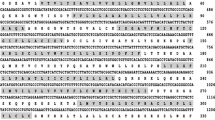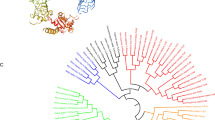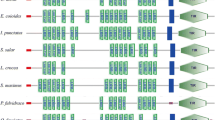Abstract
Chemokine-like receptors (CMKLRs) are multi-functional receptors with roles in regulating leukocyte and inflammation. Currently, two members of the CMKLRs, CMKLR1 and CMKLR2, have been found in salmonids, indicating that the CMKLRs had expanded from an ancestor gene in teleost fish. In the present study, the third member of the CMKLRs, defined as CMKLR3, was identified and cloned in rainbow trout. The trout CMKLR3 possessed conserved features of the CMKLR family including seven transmembrane regions, a dynein regulatory complex (DRC) motif, and two cysteine residues, but shared low sequence identities with fish CMKLR1 and CMKLR2 (24‒38 %), which was confirmed by phylogenetic tree analysis. Trout CMKLR3 was highly expressed in body kidney, head kidney, and IgM+ B cells, indicating its functional role in regulating leukocytes. We were able to modulate the expression of trout CMKLR3 in vivo by bacterial and parasitic infections but it remained apathetic to virus infection, and it was also successfully modulated in vitro by peptidoglycan and cytokines (IFN-γ and IL-6). Our results suggest that trout CMKLR3 is regulated in a complex way and has an important regulatory role in inflammatory responses.







Similar content being viewed by others
References
Allen SJ, Crown SE, Handel TM (2007) Chemokine: receptor structure, interactions, and antagonism. Annu Rev Immunol 25:787–820
Bennett LD, Fox JM, Signoret N (2011) Mechanisms regulating chemokine receptor activity. Immunology 134:246–256
Zweemer AJ, Toraskar J, Heitman LH, Ijzerman AP (2014) Bias in chemokine receptor signaling. Trends Immunol 35:243–252
Cancellieri C, Caronni N, Vacchini A, Savino B, Borroni EM, Locati M, Bonecchi R (2013) Review: structure-function and biological properties of the atypical chemokine receptor D6. Mol Immunol 55:87–93
Graham GJ, Locati M (2013) Regulation of the immune and inflammaroty by the ‘atypical’ chemokine receptor D6. J Pathol 229:168–175
Nibbs RJ, Graham GJ (2013) Immune regulation by atypical chemokine receptors. Nat Rev Immunol 13:815–829
Bachelerie F, Ben-Baruch A, Burkhardt AM, Combadiere C, Farber JM, Graham GJ, Horuk R, Sparre-Ulrich AH, Locati M, Luster AD, Mantovani A, Matsushima K, Murphy PM, Nibbs R, Nomiyama H, Power CA, Proudfoot AE, Rosenkilde MM, Rot A, Sozzani S, Thelen M, Yoshie O, Zlotnik A (2014) International Union of Pharmacology. LXXXIX. Update on the extended family of chemokine receptors and introducing a new nomenclature for atypical chemokine receptors. Pharmacol Rev 66:1–79
Zlotnik A, Yoshie O (2012) The chemokine superfamily revisited. Immunity 36:705–716
Fan P, Kyaw H, Su K, Zeng Z, Augustus M, Carter KC, Li Y (1998) Cloning and characterization of a novel human chemokine receptor. Biochem Biophys Res Commun 243:264–268
Hartmann TN, Leick M, Ewers S, Diefenbacher A, Schraufstatter I, Honczarenko M, Burger M (2008) Human B cells express the orhpan chemokine receptor CRAM-A/B in a maturation-stage-dependent and CCL5-modulated manner. Immunology 125:252–262
Leick M, Catusse J, Follo M, Nibbs RJ, Hartmann TN, Veelken H, Burger M (2009) CCL9 is a specific ligand of the constitutively recycling atyphical human chemokine receptor CRAM-B. Immunology 129:536–546
Yoshimura T, Oppenheim JJ (2008) Chemerin reveals its chimeric nature. J Exp Med 205:2187–2190
Zabel BA, Nakae S, Zuniga L, Kim JY, Ohyama T, Alt C, Pan J, Suto H, Soler D, Allen SJ, Handel TM, Galli SJ, Butcher EC (2008) Mast cell-expressed orphan receptor CCRL2 binds chemerin and is required for optimal induction of IgE-mediated passive cutaneous anaphylaxis. J Exp Med 205:2207–2220
Gantz I, Konda Y, Yang YK, Miller DE, Dierick HA, Yamada T (2006) Molecular cloning of a novel receptor (CMKLR1) with homology to the chemotactic factor receptors. Cytogenet Cell Genet 74:286–290
Wittamer V, Franssen JD, Vulcano M, Mirjolet JF, Poul EL, Migeotte I, Brézillon S, Tyldesley R, Blanpain C, Detheux M, Mantovani A, Sozzani S, Vassart G, Parmentier M, Communi D (2003) Specific recruitment of antigen-presenting cells by chemerin, a novel processed ligand from human inflammatory fluids. J Exp Med 198:977–985
Zabel BA, Silverio AM, Butcher EC (2005) Chemokine-like receptor 1 expression and chemerin-directed chemotaxis distinguish plasmacytoid from myeloid dendritic cells in human blood. J Immunol 174:244–251
Luangsay S, Wittamer V, Bondue B, Henau OD, Rouger L, Brait M, Franssen JD, Nadai PD, Huaux F, Parmentier M (2009) Mouse ChemR23 is expressed in dendritic cell subsets and macrophages, and mediates an anti-inflammatory activity of chemerin in a lung disease model. J Immunol 183:6489–6499
Samson M, Ediinger AL, Stordeur P, Rucker J, Verhasselt V, Sharron M, Govaerts C, Mollereau C, Vassart G, Doms RW, Parmentier M (1998) ChemR23, a putative chemoattractant receptor, is expressed in monocyte-derived dendritic cells and macrophages and is a coreceptor for SIV and some primary HIV-1 strains. Eur J Immunol 28:1689–1700
Yoshimura T, Oppenheim JJ (2011) Chemokine-like receptor 1 (CMKLR1) and chemokine (C-C motif) receptor-like 2 (CCRL2); Two multifunctional receptor with unusual properties. Exp Cell Res 317:674–684
Nomiyama H, Osada N, Yoshie O (2011) A family tree of vertebrate chemokine receptors for a unified nomenclature. Dev Comp Immunol 35:705–715
Zou J, Redmond AK, Qi ZT, Dooley H, Secombes CJ (2015) The CXC chemokine receptors of fish: insights into CXCR evolution in the vertebrates. Gen Comp Endocrinol 215:117–131
Grimholt U, Hauge H, Hauge AG, Leong J, Koop BF (2015) Chemokine receptors in Atlantic salmon. Dev Comp Immunol 49:79–80
Thompson J, Higgins D, Gibson T (1994) CLUSTAL W: improving the sensitivity of progressive multiple sequence alignment through sequence weighting, position-specific gap penalties and weight matrix choice. Nucleic Acids Res 22:4673–4680
Letunic I, Doerks T, Bork P (2012) SMART 7: recent updates to the protein domain annotation resource. Nucleic Acids Res 40:D302–D305
Kumar S, Tamura K, Nei M (1994) Mega-molecular evolutionary genetics analysis software for microcomputers. Comput Appl Biosci 10:189–191
Wang TH, Diaz-Rosales P, Costa MM, Compbell S, Snow M, Collet B, Martin SA, Secombes CJ (2011) Functional characterization of a nonmammalian IL-21: rainbow trout Oncorhynchus mykiss IL-21 upregulates the expression of the Th cell signature cytokines IFN-gamma, IL-10 and IL-22. J Immunol 186:708–821
Xu QQ, Li RG, Monte MM, Jiang YS, Nie P, Holland JW, Secombes CJ, Wang TH (2014) Sequence and expression analysis of rainbow trout CXCR2, CXCR3a and CXCR3b aids interpretation of lineage-specific conversion, loss and expansion of these receptors during vertebrate evolution. Dev Comp Immunol 45:201–213
Abós B, Castro R, Pignatelli J, Luque A, González L, Tafalla C (2013) Transcriptional heterogeneity of IgM + cells in rainbow trout (Oncorhynchus mykiss) tissues. PLoS ONE 8:e82737
Kumar G, Menanteau-Ledouble S, Saleh M, EI-Matbouli M (2015) Yesinia ruckeri, the causative agent of enteric redmouth disease in fish. Vet Res 46:103
Gorgoglione B, Wang TH, Secombes CJ, Holland JW (2013) Immune gene expression profiling of proliferative kidney disease in rainbow trout Oncorhynchus mykiss reveals a dominance of anti-inflammatory, antibody and T helper cell-like activities. Vet Res 44:55
Clifton-Hadley RS, Bucker D, Richards RH (1987) A study of the sequential clinical and pathological changes during proliferative kidney disease in rainbow trout, Salmo gairdneri Richardson. J Fish Dis 10:335–352
Montero J, Garcia J, Ordas MC, Casanova I, Gonzalez A, Villena A, Coll J, Tafalla C (2011) Specific regulation of the chemokine response to viral hemorrhagic septicemia virus at the entry site. J Virol 85:4046–4056
Cuesta A, Tafalla C (2009) Transcription of immune genes upon challenge with viral hemorrhagic septicemia virus (VHSV) in DNA vaccinated rainbow trout (Oncorhynchus mykiss). Vaccine 27:280–289
Costa MM, Maehr T, Diaz-Rosales P, Secombes CJ, Wang TH (2011) Bioactivity studies of rainbow trout (Oncorhynchus mykiss) interleukin-6: effects on macrophage growth and antimicrobial peptide gene expression. Mol Immunol 48:1903–1916
Hong S, Li RG, Secombes CJ, Wang TH (2013) Two types of TNF-α exist in teleost fish: phylogeny, expression, and bioactivity analysis of type-II TNF-α3 in rainbwo trout Oncorhynchus mykiss. J Immunol 191:5959–5972
Harun NO, Wang TH, Secombes CJ (2011) Gene expression profiling in naïve and vaccinated rainbow trout after Yersinia ruckeri infection: insights into the mechanisms of protection seen in vaccinated fish. Vaccine 29:4388–4399
Raida MK, Holten-Andersen L, Buchmann K (2011) Association between Yersinia ruckeri infection, cytokine expression and survival in rainbow trout (Oncorhynchus mykiss). Fish Shellfish Immunol 30:1257–1264
Qi ZT, Jiang YS, Holland JW, Nie P, Secombes CJ, Wang TH (2015) Identification and expression analysis of an atypical chemokine receptor-2 (ACKR2)/CC chemokine binding protein-2 (CCBP2) in rainbow trout (Oncorhynchus mykiss). Fish Shellfish Immunol 44:389–398
Aquilino C, Castro R, Fisher U, Tafalla C (2014) Transcriptomic response in rainbow trout gills upon infection with viral hemorrhagic septicemia virus (VHSV). Dev Comp Immunol 44:12–20
Savan R, Ravichandran S, Collins JR, Sakai M, Young HA (2009) Structural conservation of interferon γ among vertebrates. Cytokine Growth Factor Rev 20:115–124
Costa MM, Maehr T, Diaz-Rosales P, Secombes CJ, Wang T (2011) Bioactivity studies of rainbow trout (Oncorhynchus mykiss) interleukin-6: effects on macrophage growth and antimicrobial peptide gene expression. Mol Immunol 48:1903–1916
Arita M, Bianchini F, Aliberti J, Sher A, Chiang N, Hong S, Zhang R, Petasis NA, Serhan CN (2005) Stereochemical assignment, antiinflammatory properties, and receptors for the omega-3 lipid mediator resolvin E1. J Exp Med 201:713–722
Acknowledgments
This work was supported by the Scottish Funding Council for the MASTS (the Marine Alliance for Science and Technology for Scotland) (grant reference HR09011) and partially by grants from the National Natural Science Foundation of China (31302221, 31272666, and 31470130). ZQ was financially supported by the “Qinglan” project of Jiangsu Province and the overseas training plan for young and middle-aged teachers and principals of colleges and universities in Jiangsu Province, China. We thank Professor Mingxian Chang, State Key Laboratory of Freshwater Ecology and Biotechnology, Institute of Hydrobiology, the Chinese Academy of Sciences, for her kind comments on the phylogenetic tree analysis.
Author information
Authors and Affiliations
Corresponding author
Electronic supplementary material
Below is the link to the electronic supplementary material.
Rights and permissions
About this article
Cite this article
Qi, Z., Zhang, Q., Holland, J.W. et al. Characterization and expression analysis of chemokine-like receptor 3 gene in rainbow trout Oncorhynchus mykiss . Fish Sci 82, 613–622 (2016). https://doi.org/10.1007/s12562-016-0997-5
Received:
Accepted:
Published:
Issue Date:
DOI: https://doi.org/10.1007/s12562-016-0997-5




